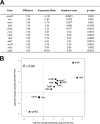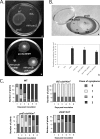PecS is a global regulator of the symptomatic phase in the phytopathogenic bacterium Erwinia chrysanthemi 3937
- PMID: 18790868
- PMCID: PMC2576657
- DOI: 10.1128/JB.00553-08
PecS is a global regulator of the symptomatic phase in the phytopathogenic bacterium Erwinia chrysanthemi 3937
Abstract
Pathogenicity of the enterobacterium Erwinia chrysanthemi (Dickeya dadantii), the causative agent of soft-rot disease in many plants, is a complex process involving several factors whose production is subject to temporal regulation during infection. PecS is a transcriptional regulator that controls production of various virulence factors. Here, we used microarray analysis to define the PecS regulon and demonstrated that PecS notably regulates a wide range of genes that could be linked to pathogenicity and to a group of genes concerned with evading host defenses. Among the targets are the genes encoding plant cell wall-degrading enzymes and secretion systems and the genes involved in flagellar biosynthesis, biosurfactant production, and the oxidative stress response, as well as genes encoding toxin-like factors such as NipE and hemolysin-coregulated proteins. In vitro experiments demonstrated that PecS interacts with the regulatory regions of five new targets: an oxidative stress response gene (ahpC), a biosurfactant synthesis gene (rhlA), and genes encoding exported proteins related to other plant-associated bacterial proteins (nipE, virK, and avrL). The pecS mutant provokes symptoms more rapidly and with more efficiency than the wild-type strain, indicating that PecS plays a critical role in the switch from the asymptomatic phase to the symptomatic phase. Based on this, we propose that the temporal regulation of the different groups of genes required for the asymptomatic phase and the symptomatic phase is, in part, the result of a gradual modulation of PecS activity triggered during infection in response to changes in environmental conditions emerging from the interaction between both partners.
Figures





Similar articles
-
Characterization of indigoidine biosynthetic genes in Erwinia chrysanthemi and role of this blue pigment in pathogenicity.J Bacteriol. 2002 Feb;184(3):654-65. doi: 10.1128/JB.184.3.654-665.2002. J Bacteriol. 2002. PMID: 11790734 Free PMC article.
-
Definition of a consensus DNA-binding site for PecS, a global regulator of virulence gene expression in Erwinia chrysanthemi and identification of new members of the PecS regulon.J Biol Chem. 2004 Jul 16;279(29):30158-67. doi: 10.1074/jbc.M403343200. Epub 2004 May 12. J Biol Chem. 2004. PMID: 15140891
-
PecS is an important player in the regulatory network governing the coordinated expression of virulence genes during the interaction between Dickeya dadantii 3937 and plants.Environ Microbiol. 2011 Nov;13(11):2901-14. doi: 10.1111/j.1462-2920.2011.02566.x. Epub 2011 Sep 12. Environ Microbiol. 2011. PMID: 21906221
-
Regulation of bacterial virulence genes by PecS family transcription factors.J Bacteriol. 2024 Oct 24;206(10):e0030224. doi: 10.1128/jb.00302-24. Epub 2024 Sep 17. J Bacteriol. 2024. PMID: 39287432 Free PMC article. Review.
-
Regulation of pectinolysis in Erwinia chrysanthemi.Annu Rev Microbiol. 1996;50:213-57. doi: 10.1146/annurev.micro.50.1.213. Annu Rev Microbiol. 1996. PMID: 8905080 Review.
Cited by
-
lpxC and yafS are the most suitable internal controls to normalize real time RT-qPCR expression in the phytopathogenic bacteria Dickeya dadantii.PLoS One. 2011;6(5):e20269. doi: 10.1371/journal.pone.0020269. Epub 2011 May 26. PLoS One. 2011. PMID: 21637857 Free PMC article.
-
Top 10 plant pathogenic bacteria in molecular plant pathology.Mol Plant Pathol. 2012 Aug;13(6):614-29. doi: 10.1111/j.1364-3703.2012.00804.x. Epub 2012 Jun 5. Mol Plant Pathol. 2012. PMID: 22672649 Free PMC article. Review.
-
Regulation of the Synthesis and Secretion of the Iron Chelator Cyclodipeptide Pulcherriminic Acid in Bacillus licheniformis.Appl Environ Microbiol. 2018 Jun 18;84(13):e00262-18. doi: 10.1128/AEM.00262-18. Print 2018 Jul 1. Appl Environ Microbiol. 2018. PMID: 29703732 Free PMC article.
-
Plant phenolic acids affect the virulence of Pectobacterium aroidearum and P. carotovorum ssp. brasiliense via quorum sensing regulation.Mol Plant Pathol. 2016 May;17(4):487-500. doi: 10.1111/mpp.12295. Epub 2015 Sep 7. Mol Plant Pathol. 2016. PMID: 26177258 Free PMC article.
-
Cross-talk between a regulatory small RNA, cyclic-di-GMP signalling and flagellar regulator FlhDC for virulence and bacterial behaviours.Environ Microbiol. 2015 Nov;17(11):4745-63. doi: 10.1111/1462-2920.13029. Epub 2015 Oct 14. Environ Microbiol. 2015. PMID: 26462993 Free PMC article.
References
-
- Andrews, J. 2001. Determination of minimum inhibitory concentrations J. Antimicrob. Chemother. 485-16. - PubMed
-
- Bardonnet, N., and C. Blanco. 1992. ′uidA-antibiotic-resistance cassettes for insertion mutagenesis, gene fusions and genetic constructions. FEMS Microbiol. Lett. 72243-248. - PubMed
-
- Beaulieu, C., M. Boccara, and F. Vangijsegem. 1993. Pathogenic behavior of pectinase-defective Erwinia chrysanthemi mutants on different plants. Mol. Plant-Microbe Interact. 6197-202.
-
- Benjamini, Y., and Y. Hochberg. 1995. Controlling the false discovery rate: a practical and powerful approach to multiple testing. J. Royal Stat. Soc. Ser. B 57289-300.
-
- Boccara, M., A. Diolez, M. Rouve, and A. Kotoujansky. 1988. The role of the individual pectate lyases of Erwinia chrysanthemi strain 3937 in pathogenicity on Saintpaulia plants. Physiol. Mol. Plant Pathol. 3395-104.
Publication types
MeSH terms
Substances
LinkOut - more resources
Full Text Sources
Molecular Biology Databases

